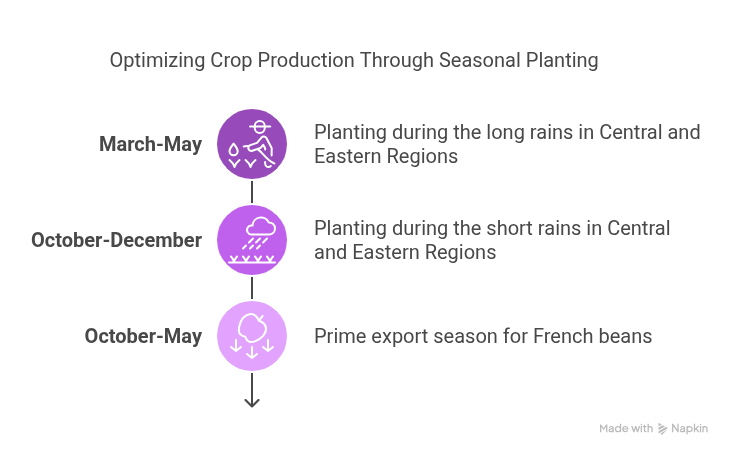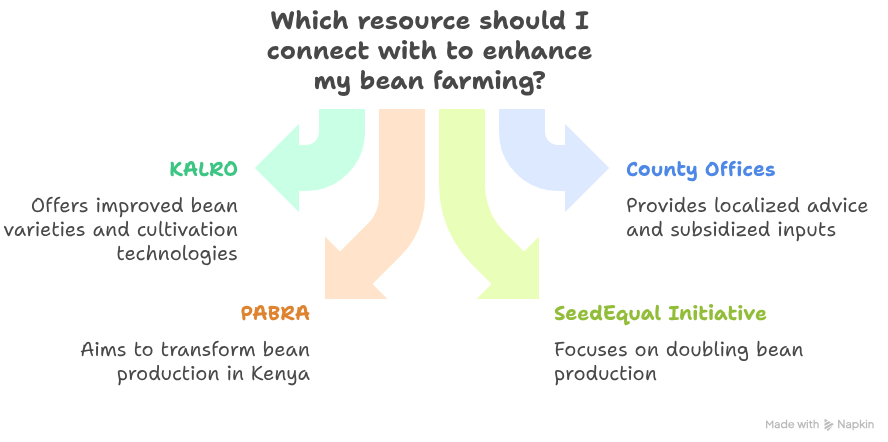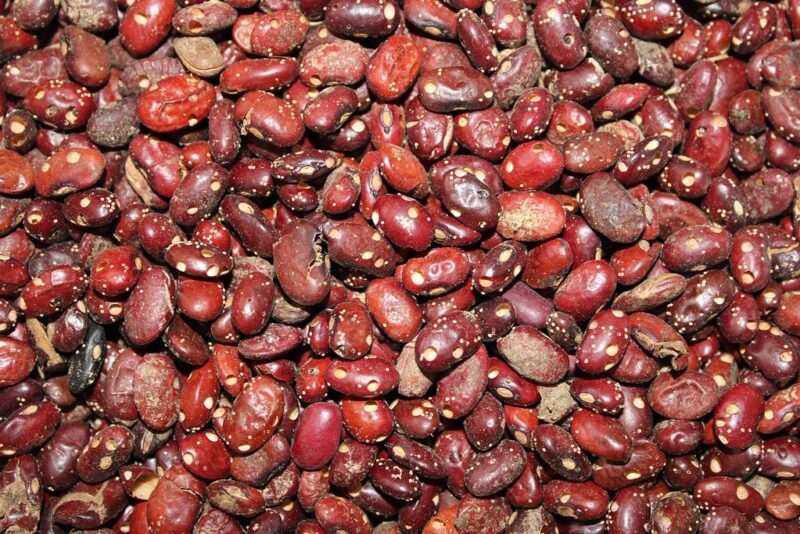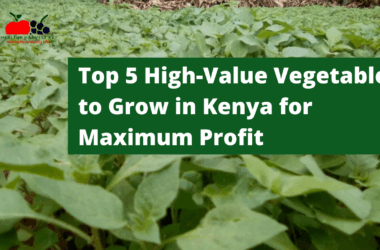Why Beans Matter in Kenya
If you’re looking for a crop that delivers both at the dinner table and the market, beans are your answer. As Kenya’s second most important food crop after maize, beans aren’t just feeding families—they’re building businesses. Whether you’re farming a small plot in Eastern Kenya or managing acres in the Rift Valley, beans offer serious profit potential with relatively low investment.
Here’s the deal: Kenya produces about 600,000-780,000 metric tons of beans annually, but we consume around 750,000 metric tons. That gap? It’s your opportunity. With the right approach, beans farming can transform from a subsistence activity into a proper money-maker that supports your household while contributing to Kenya’s food security.
The Bean Farming Landscape in Kenya
Kenya ranks as the seventh largest producer of common beans globally—no small achievement for our farmers. The industry engages about 1.5 million smallholder farmers who collectively cultivate beans on approximately one million hectares of land throughout the country.
If you’re wondering where most beans come from, the Rift Valley leads production with 33% of the national output, followed by Eastern (24%), Central (20%), Lake Victoria zone (18%), and Western regions (13%). Each region brings different growing conditions to the table, affecting which varieties thrive and when planting works best.
The average Kenyan consumes about 14kg of beans annually, but this figure jumps to a whopping 66kg per person in western regions where beans are a dietary staple. This consistent demand creates a stable market for your harvest.
Top Bean Varieties for Kenyan Farmers
Choosing the right bean variety can make or break your farming success. Here are the varieties that are proving their worth in Kenyan fields:
Commercial Favorites
Mwitemania Beans These speckled beans have become a farmer favorite for good reason. Developed by KALRO (Kenya Agricultural and Livestock Research Organization), Mwitemania matures in 75-90 days and can yield 10-15 bags (90kg each) per acre under good conditions. They adapt well to various soil types, making them versatile across different regions.
KAT X56 Another KALRO success story, KAT X56 shares a similar growth timeline with Mwitemania (75-90 days) but has its own distinct characteristics. Expect yields of 10-15 bags per acre when you follow proper farming practices. Farmers appreciate this variety for its consistent performance across multiple growing zones.
Wairimu Beans (Rose Coco) If you’re looking for a variety that Kenyan consumers already know and love, Wairimu beans fit the bill. These medium-sized, light pink beans mature in 75-90 days and typically yield 8-12 bags per acre. Their established market presence makes them an easy sell at local markets.
Specialized Varieties Worth Considering
Nyota (Iron-Biofortified) Released in 2017, Nyota (meaning “star” in Kiswahili) lives up to its name. This iron-biofortified variety reached production levels of 50,000 metric tons within just four years of its release—accounting for about 8% of Kenya’s annual bean production. Nyota offers both nutritional benefits and market premium potential.
French Beans (Mishiri) If you’re near good markets and have irrigation access, French beans could be your ticket to export earnings. They thrive at altitudes between 1,500-2,100 meters with well-distributed rainfall (900-1,200mm annually) or weekly irrigation of about 50mm. The export potential makes them attractive for commercially-minded farmers.
Practical Farming Guide: From Soil to Harvest
Soil and Climate Requirements
Beans aren’t divas about soil—they’ll grow in everything from sandy to clay loams—but they do prefer well-drained soil with good organic matter content. Aim for soil pH between 6.5 and 7.5, though some varieties tolerate more acidic conditions down to pH 4.5.
Temperature-wise, beans perform best between 20-25°C, though they can handle a range of 14-32°C depending on the variety. This flexibility explains why beans thrive across Kenya’s diverse growing regions.
Water Management: The Make-or-Break Factor
Water management can determine whether you’re counting bags or losses at harvest. Beans generally need about 900-1,200mm of rainfall throughout their growing season. If you’re in an area with unpredictable rainfall, consider supplemental irrigation, especially during flowering and pod formation when water stress can drastically reduce yields.
For irrigated production, provide approximately 50mm of water weekly to maintain optimal growth. This consistent moisture supply is particularly critical for export varieties like French beans where quality standards are strict.
Seasonal Planting Guide by Region
Rift Valley and Western Regions Most farmers here plant during the March-May rainy season, focusing on a single crop cycle annually. The reliable rainfall during this period typically provides sufficient moisture for the entire growing season.
Central and Eastern Regions If you’re farming in these areas, you’ve got two potential planting windows. In the Eastern region, about 70% of bean farmers plant during the long rains (March-May), while almost all farmers in both regions plant during the short rains (October-December). This dual-season approach can maximize your annual production and cash flow.
For Export-Oriented Production If you’re growing French beans for export, you can potentially produce year-round with irrigation. However, the prime export season runs from October to May when market demand peaks and growing conditions are optimal.

Overcoming Common Farming Challenges
Climate Change Adaptations
Let’s face it—the weather isn’t what it used to be. Disrupted rainfall patterns, temperature swings, and more frequent droughts are making traditional planting calendars less reliable. Here’s how to adapt:
- Diversify your bean varieties to spread risk
- Consider drought-tolerant varieties like KAT B1 and KAT B9
- Implement water conservation techniques like mulching
- Watch weather forecasts and adjust planting dates accordingly
Pest and Disease Management
Bean farming comes with its share of unwanted visitors. Bean root rot can cause complete crop failure, especially in high-rainfall areas like Kitale. The bean stem maggot (Ophiomyia spp.) is another serious threat, attacking young plants and potentially causing significant losses.
Implement these protective measures:
- Practice crop rotation with non-legumes
- Use certified, disease-free seed
- Apply appropriate pesticides at recommended rates and times
- Consider integrated pest management approaches that combine cultural, biological, and chemical controls
Soil Fertility Solutions
Continuous cultivation without proper soil management leads to declining yields. While beans can fix some atmospheric nitrogen, they still need balanced nutrition. Consider these practices:
- Apply phosphorus-rich fertilizers at planting (DAP works well)
- Incorporate well-decomposed manure before planting
- Practice crop rotation with cereals like maize
- Consider inoculating seeds with rhizobium bacteria to enhance nitrogen fixation
The Economics of Bean Farming: Making It Pay
Cost-Benefit Breakdown
Let’s talk money. Bean farming offers attractive economics with relatively low establishment costs. On average, cultivating an acre of beans costs between KES 10,000 to 15,000 (approximately USD 100-150), covering land preparation, seed purchase, and basic crop management.
Here’s a simple breakdown of potential returns:
| Input/Output | Amount | Cost/Return (KES) |
|---|---|---|
| Land preparation | 1 acre | 3,000 – 4,000 |
| Certified seed | 25-30 kg | 3,000 – 4,500 |
| Fertilizer | DAP, 50 kg | 2,500 – 3,000 |
| Pest control | Various | 1,500 – 2,500 |
| Labor | Planting to harvest | 2,000 – 3,000 |
| Total Cost | 12,000 – 17,000 | |
| Yield (Average) | 8-12 bags (90kg each) | 48,000 – 72,000 |
| Potential Profit | 31,000 – 60,000 |
Note: Prices vary by region and season. This table assumes current average market prices of KES 6,000 per 90kg bag.
The relatively short growing cycle of 75-90 days for most varieties means quicker capital turnover compared to longer-season crops, allowing for potentially two income cycles annually in some regions.
Market Opportunities You Shouldn’t Miss
The current production shortfall of approximately 150,000 metric tons annually represents immediate market potential. This gap is currently filled through imports from neighboring countries like Tanzania, Uganda, and Ethiopia—imports that could be replaced by your production.
Beyond the traditional dry bean market, consider these specialized opportunities:
- Biofortified varieties like Nyota can command premium prices in nutrition-conscious markets
- Export-quality French beans offer significant income potential if you can meet quality standards
- Value-added processing like sorting, grading, and packaging can increase your profit margins
- Seed production for improved varieties offers higher returns than grain production
Future-Proofing Your Bean Farming Business
Expansion Strategies
There are ambitious plans to expand bean production from the current one million acres to five million acres nationally, particularly by developing production in non-traditional growing areas. Consider whether expanding your bean acreage or introducing beans to new areas of your farm could increase your overall farm profitability.
Current bean yields in Kenya average about 0.6 metric tons per hectare, well below potential. Through improved varieties, better agronomic practices, and enhanced pest and disease management, you could potentially double or triple your yields without expanding your cultivated area.
Accessing Better Resources
To take your bean farming to the next level, connect with these valuable resources:
- KALRO (Kenya Agricultural and Livestock Research Organization) for improved varieties and cultivation technologies
- County agricultural extension offices for localized advice and potential subsidized inputs
- The Pan-Africa Bean Research Alliance (PABRA) which is working to transform bean production in Kenya
- SeedEqual Initiative which aims to double bean production to 1.2 million metric tons

Your Next Steps in Bean Farming
Beans farming in Kenya offers significant potential for both food security and income generation. With the right variety selection, proper agronomic practices, and smart marketing strategies, you can transform beans from a subsistence crop to a profitable enterprise.
The gap between production and consumption creates immediate opportunities for expanded cultivation, while emerging markets for specialized varieties and value-added products offer pathways to premium prices.
Start by selecting varieties suited to your specific growing conditions, implement the best practices outlined above, and consider gradually scaling up production as you master the crop. With each season, you’ll not only improve your household food security but potentially create a sustainable business that contributes to Kenya’s agricultural transformation.
Ready to get started? Your first step is securing quality seed of your chosen variety from certified dealers or KALRO centers near you.
Have questions about beans farming in Kenya? Drop them in the comments below, and our agricultural experts will respond!










